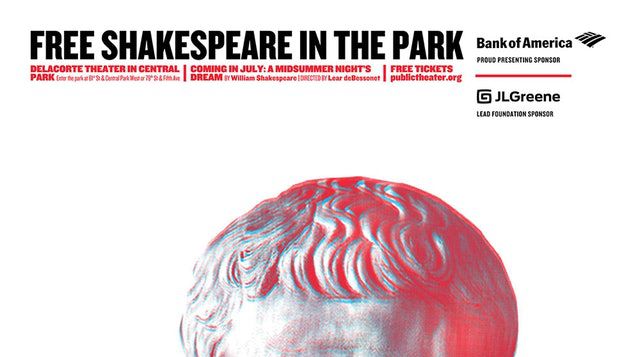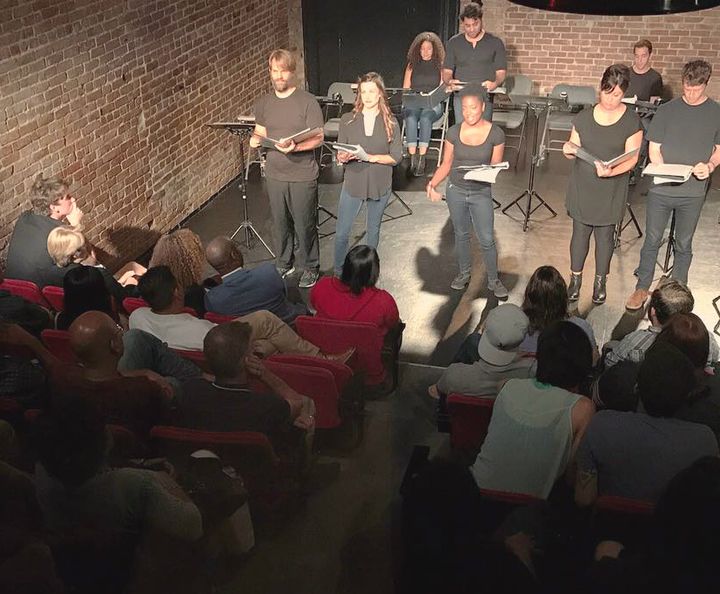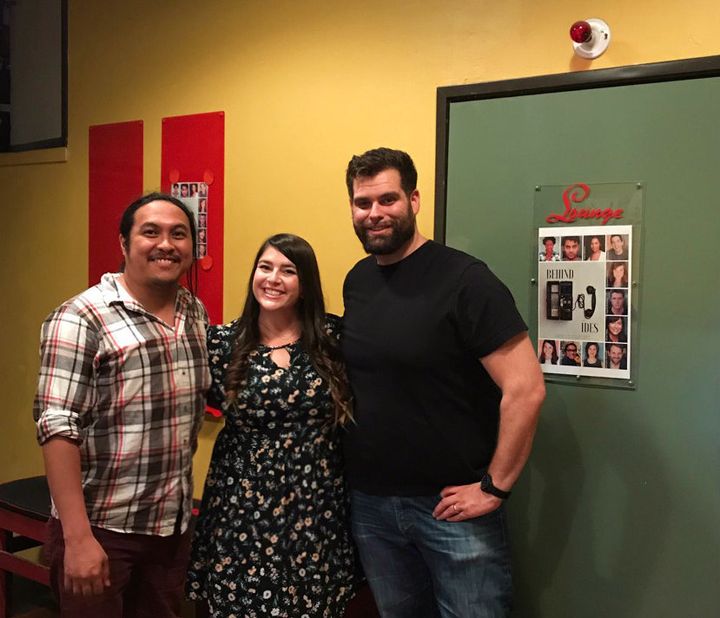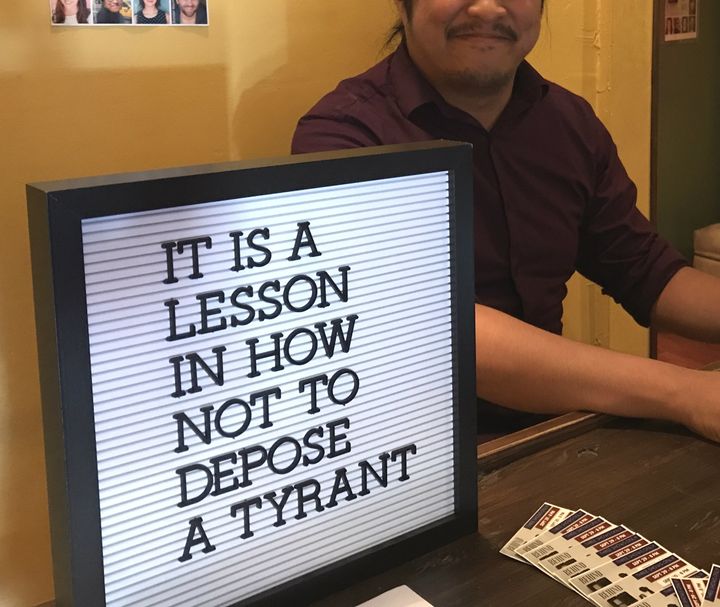
Content Warning: Quotations of very strong, abusive language.
That Escalated Quickly
It began with a single phone call this past June to New York City’s famed Public Theater:
Tell that fucking bitch to get out of my country. I think it’s absolutely disgraceful what you guys are doing. You all are fucked up!
More such calls followed, sporadically at first. Then within hours, the Public’s ticket office was completely overwhelmed by thousands of abusive calls, all responses to reports that the company’s production of Julius Caesar showed Donald Trump being assassinated. A small group of ticket operators came to endure nearly two weeks of daily verbal and emotional abuse as they attempted to handle, calmly and professionally, the raging torrent directed at them.
Although box office operators have rarely, if ever, been the protagonists of literary opuses, a brand new 75-minute play, Behind the Ides, tells the real-life story of those who worked at the Public during the Trumpian furor. It premiered last weekend as dramatic staged readings at Hollywood’s Lounge Theatre, with each show featuring an ensemble of eight actors voicing over 80 parts. Getting to experience it on opening night was a truly powerful experience for me.

One of the first rehearsals for the Behind the Ides cast.
Part of the play’s impact comes from the fact that playwright David Armstrong, a member of the Public’s staff, depicts events that happened to real people. But he also uses numerous word-for-word quotations of actual calls to the Public, making the trauma that the operators experience more shocking, and their struggle to cope more moving.
The play then confronts audiences with essentially the same question many of us Americans have been wrestling with lately. I’d put it this way:
How do I engage fellow citizens whose fundamental values seem very different from mine, especially those who feel threatened by people like me, and who also support policies that threaten me and my loved ones?
Much Ado About Something

The top of a publicity poster for the Public’s staging of Julius Caesar shows how important Bank of America’s sponsorship had been.
In Behind the Ides’ first act, the Public Theater controversy is just beginning. Perhaps you’ve previously heard about the actual uproar this past summer, which exploded when Trump-friendly media corporations Fox News and The Blaze, along with white supremacist website Breitbart, devoted major air time and screen space to the story. Though the Public has for years been one of the nation’s leading theater companies, winning over 50 Tony Awards and premiering highly successful musicals like Hair, A Chorus Line, and Hamilton, corporate sponsors Bank of America and Delta Airlines consequently withdrew their financial support. Even the National Endowment for the Arts distanced itself from the organization.
Unquestionably, the Public’s rendition of Julius Caesar intentionally resembles Trump:

Yet I think most folks who’ve been to a Shakespearean play know that it’s customary for characters to wear attire that either pre- or post-dates the era in which the story is actually set. For its Julius Caesar, the Public presented characters from first century B.C. Rome in costumes evoking present-day America.
In fact, other theaters around the country have long cast their Caesars to look like whomever was president at the time. In one production or other, Caesar has resembled nearly every president since Ronald Reagan, including President Obama in a 2012 Minneapolis staging by the Guthrie Theater:

Behind the Ides shows how the Public and its ticket operators even took pains to clarify that the murdered character isn’t Trump, but Caesar, and that the resemblance aims to provoke thought, not promote disrespect or violence. In fact, that’s the underlying message of Shakespeare's tragedy.
(SPOILER ALERT IF YOU DON’T KNOW WHAT HAPPENS IN JULIUS CAESAR!)
Because far from being painted as heroes, Brutus and his conspirators are condemned for their violence. The fact that they were attempting to save Rome from authoritarian rule doesn’t at all justify their killing Caesar. The ends doesn’t justify the means.
But that’s not how thousands of Trump supporters interpreted it.
Say What?

Showtime. Some guy with a chrome dome in the audience, bottom left. (Yeah, me.)
Perhaps the abusive call in Behind the Ides that disturbs me most is this one, taken verbatim from the Public Theater box office’s voicemail:
You people are sick. You are disgusting. You are glorifying violence. It’s actually really, really sad. Really fucking sad and pathetic. You all think you’re so brave, putting on a show like this, and it’s just some sick, depraved fantasy. And then you hide behind your chickenshit email from the 1980s. Be ashamed. It’s shameful. You are not Christians. You are not good people. You should all burn in Hell for this. I will pray for you, but I don’t think there’s much hope for you, honestly.
As a former minister who pastored evangelical churches for more than a dozen years, I’ve definitely known folks like this. More basically, as someone who still identifies as a Christian after nearly 40 years of faith, I’m embarrassed.
But though embarrassed, I’m glad Behind the Ides includes this voicemail in the script. (Sadly, it’s not the only one that’s piously high and mighty.) It epitomizes for us what not to do when attempting to engage fellow citizens whose values appear quite different from our own.
Solving Division Problems
And even though Armstrong's play depicts just how awful Americans can be to their fellow citizens, it also shows how the box office operators strove to rise above the meanness. In so doing, it prods members of the audience to consider how they, too, might do that, in a country not just torn, but seemingly shredded by bitter divisions.
Such a country desperately needs works of art that provoke and heal. Behind the Ides is such a work - a story that presents this ugly moment in our history truthfully, yet with realistic hope for our future.
In fact, Armstrong wrote the play with this in mind. He says, “The fact that each [audience member] I have spoken to has found something to connect to, or be moved by, speaks to a need that had to be filled.”
Producer Ben Goldberg agrees. He says, “In times of hardship or anger, art is a tool to release emotions and bring us together, and that's what this piece is intended to do.”

Playwright David Armstrong, director Joan Marie Hurwit, and producer Ben Goldberg. David and Joan have partnered on projects for a decade, going back to their days at San Diego State.
Collaborating with Armstrong for the play’s Los Angeles run was director Joan Marie Hurwit, a personal friend of mine. I first met her through her work with Native Voices at the Autry. She’s very thoughtful, incredibly hard-working, and passionately committed to producing works that benefit the communities in which they are staged.
Before opening night, I asked her what she hoped the play would accomplish, and she said, “When we tell stories about the social climate, we implore audiences to not only engage in a conversation with us, but also to carry that consciousness back into our communities. I hope Behind the Ides provides a foundation for people, especially of differing viewpoints, to have a conversation. When art brings us together, that's a beautiful place to start.”
Art for Artists’ Sakes, Too

Playwright David Armstrong (left photo, gesturing) and members of the Behind the Ides cast converse with the audience on opening night.
These themes were echoed by the rest of the cast, which returned to the stage after each performance for a half-hour, reflective conversation with the audience. As I listened opening night, I was struck by how impacted the actors themselves felt. I was able to follow up with several of them after the show, and it became clear that something powerful was happening behind the scenes of Behind the Ides.
One of the show’s swing actors, Anna Garcia, highlighted the challenge the cast faced in understanding their antagonistic characters: “As humans, there’s something that connects us, a uniting thread that’s incredibly difficult to see nowadays, especially behind what feels like layers of hate and ignorance on the opposing side.”
Some cast members expressed how portraying the angry callers gave them a deeper empathy for even the most offensive ones. Brendan Cadigan Weinhold, who plays a number of furious callers, told me, “Hearing [their words] out loud on stage, spoken with passion, I could begin to understand why they screamed hateful things. They’re desperately trying to get someone to listen.”
Dani Woodson, whose most powerful role in the play is that of an angry caller who actually engages one operator in a civil dialogue, felt similarly. She said, “Behind the Ides forces me to play real human beings who have the opposite opinion of what I feel. The only proper way to do that is not to judge them, but to take a step back and try to understand where they come from.”
Despite the terrible things the callers say, the play attempts to humanize, rather than caricaturize, them. Sierra Santana, who portrays, in addition to ten other characters, a box office operator pushed to the breaking point, said of the callers, “They are in your face, no holds barred, and generally, tragically misinformed. But these are our neighbors, our family members and our fellow Americans.”
The narrator and moral compass of the play, Nardeep Khurmi, added, “It's so easy to get caught in your own bubble with people that agree with you, but this piece forces you to experience the opposing viewpoint, even if delivered vitriolically.”

The cast. Top row, left to right: Dani Woodson, Nardeep Khurmi, and Sierra Santana. Middle row: Jonathan Brett, Allison Hudson Hicks, and Brendan Cadigan Weinhold. Bottom row: Anna Garcia, August Browning, and Stephanie Wilson.
Other cast members expressed hope in Behind the Ides’ potential to facilitate healing. Allison Hudson Hicks, whose most prominent role in the play is that of an older woman heartbroken by all the violence she’s witnessed, said, “This play reveals the toll on the human heart by the hate being unleashed now. I hope it provokes compassionate, respectful dialogue.”
Jonathan Brett, who, among other characters, portrays a Jewish staffer accused by a caller of being a Nazi, expressed this more specifically. He said, “If even one conversation can come that opens the mind of another person about a side they had refused to explore, then we have done our job.”
Playwright Armstrong sees theater as vital in that endeavor. He told me, “Theater is disarming, because it engages such a different part of our brains than simply talking or arguing. Part of finding ways to relate to each other is finding new ways of thinking. Theater subtly makes you think in new ways.”

In case anyone was still wondering.
Entr’acte
So rich were the thoughts of those involved in the production, there ought to be another play - Behind Behind the Ides. (How meta!) I’m truly disappointed that space precludes the inclusion of more of their wonderful takes.
One of the most on-point responses from another audience member came from Kyla Garcia, one of the lead actors in a play I reviewed earlier this year, Mary Kathryn Nagle’s Fairly Traceable. Kyla said, “We are saturated with social media algorithms that allow us to see only what we are interested in, or that push people we agree with to the top of our news feeds. Only those who agree speak to one another, and those who don't are unfriended or blocked. But we teach our children to listen and play well with others, even if they don't agree. So this show could not have come at a more perfect time.”
Amen to that! What’s good for kids is still good for grown-ups.
And if you’re wondering if I took my daughters (ages eight and eleven) to the staged reading, the answer is that I didn’t, due to the raw and abusive language. But I hope they’ll be ready to see it in a few years. In the meantime, my wife and I will continue to teach and, hopefully, model for them how to relate in healthy and productive ways to people with whom they don’t see eye to eye.
And yes, I did refer to future Behind the Ides performances! The folks who made the play happen are working on that, optimistic that there will be more to come. I can’t wait to see it again!
Remember Behind the Ides, my friends. And when you get the chance, go experience it, and lend it your ears.
UPDATE: Emerging Arts Leaders/Los Angeles presents a free staged reading of Behind the Ides on Wednesday, Nov. 1! Details here; you must RSVP through Eventbrite.

(Stay up to date with all developments involving Behind the Ides here. Comments not from the author in this post have been slightly edited for clarity.)
A married father of two daughters, Eugene Hung is a Southern California-based advocate for social justice, especially as it relates to the rights of women and girls. He blogs at FeministAsianDad.com.
